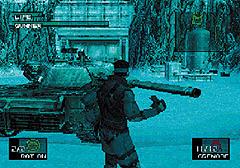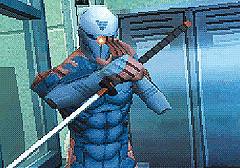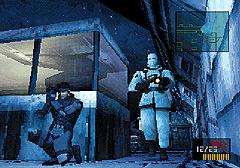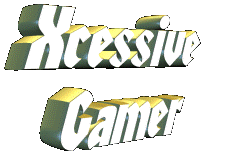


 This review comes after only over 20 hours of playtime, still on the first
of two disks. It is meant to provide a relatively accurate accessment of
the quality of the game.)
This review comes after only over 20 hours of playtime, still on the first
of two disks. It is meant to provide a relatively accurate accessment of
the quality of the game.)
Metal Gear Solid was produced by Konami and released in Japan on September 3rd, just 4 days before this review. The game comes with 3 compact disks, two for MGS and one for the playable demo of Suikoden. The cover design is extremely plain (much like that for Final Fantasy VII)- in Japan, that appears to be an indication of top-notch quality, as I will describe. A sticker on the plastic wrap states that a Japanese magazine (Famitsu Weekly) has review the game and gave its best rating. An indication of things to come.
 The game starts with a movie
showing a submarine racing toward some destination, in an artistic style
that is distinctly MGS: dark, primary colors, and solid polygons and shades.
Konami had elected to not use CGI and decided on rendering the movie using
hi-res polygons, and it really pays off. The transitions from the actual
game and the cut-scenes are flawless and offer no distractions. The cinematography
is superbly done, and the letterbox format makes you feel like you're watching
a movie. So the story begins... Armed terrorists have ransomed the world
with a nuclear threat, and they have built a hide-out on an island off
the coast of Alaska. You're Solid Snake, the legendary hero sent with two
initial missions: (1) to rescue two hostages, one arms supplier president
(Kenneth Baker) and one team leader, and (2) to find out if the terrorists'
threat is real. The way for Solid Snake to reach the island hide-out is
by getting close to the island by being shot out within a torpedo (SDV-
Small Delivery Vehicle), then he must get out and swim to the island. Time
is limited, and Snake didn't bring anything with him (except for a communication
device implanted in his ear). From here, the plot thickens and the
action starts.
The game starts with a movie
showing a submarine racing toward some destination, in an artistic style
that is distinctly MGS: dark, primary colors, and solid polygons and shades.
Konami had elected to not use CGI and decided on rendering the movie using
hi-res polygons, and it really pays off. The transitions from the actual
game and the cut-scenes are flawless and offer no distractions. The cinematography
is superbly done, and the letterbox format makes you feel like you're watching
a movie. So the story begins... Armed terrorists have ransomed the world
with a nuclear threat, and they have built a hide-out on an island off
the coast of Alaska. You're Solid Snake, the legendary hero sent with two
initial missions: (1) to rescue two hostages, one arms supplier president
(Kenneth Baker) and one team leader, and (2) to find out if the terrorists'
threat is real. The way for Solid Snake to reach the island hide-out is
by getting close to the island by being shot out within a torpedo (SDV-
Small Delivery Vehicle), then he must get out and swim to the island. Time
is limited, and Snake didn't bring anything with him (except for a communication
device implanted in his ear). From here, the plot thickens and the
action starts.
 Personally, what is most
impressive about Metal Gear Solid is the gamemaker's attempt to create
a alternate reality. Metal Gear Solid is built around a complete world,
and it shows in the in-game briefing and text descriptions of Solid Snake's
previous missions. (I should note that I didn't play any of the previous
games. They must have been impressive.) This world then is used to carry
a deep and complicated story that gradually unfolds and sucks the player
in. The story can always be reviewed everytime you reload an old game,
just so that you stay on top of what has happened. Also, during the progression
of the plot, Solid Snake develops from a stoic, war-worn soldier to a more
caring person.In this process, he is helped by his various assistants who
advice him on the wireless, implanted radio. These assistants, ranging
from weapons specialists and mentor to communication officer to mysterious
friends, all have distinctive personalities and have engaging stories to
tell.
Personally, what is most
impressive about Metal Gear Solid is the gamemaker's attempt to create
a alternate reality. Metal Gear Solid is built around a complete world,
and it shows in the in-game briefing and text descriptions of Solid Snake's
previous missions. (I should note that I didn't play any of the previous
games. They must have been impressive.) This world then is used to carry
a deep and complicated story that gradually unfolds and sucks the player
in. The story can always be reviewed everytime you reload an old game,
just so that you stay on top of what has happened. Also, during the progression
of the plot, Solid Snake develops from a stoic, war-worn soldier to a more
caring person.In this process, he is helped by his various assistants who
advice him on the wireless, implanted radio. These assistants, ranging
from weapons specialists and mentor to communication officer to mysterious
friends, all have distinctive personalities and have engaging stories to
tell.
They fill the MGS world and
brings it to life.
Now, the game... The
first thing you will notice is the visual, the graphics. There is an enormous
attention to
detail, and that detail
requires some top-notch graphics from the 3-year-old PlayStation. And it
surely delivers.
The details in MGS comes
in the form of hi-res textures that doesn't pixelate much when you zoom
in (more on
this later), and the
polygons are solid and exhibit no break-ups. Although most of the game
is played in the
top-down perspective,
you can change the view to a 1st person view by using a single button or
by using a binoculars.
Next, of course the graphics
are built around a world in which Solid Snake can move around in. The level
designs are excellent, ranging from in-door hangers with elevated walkways
to out-door areas with caves and
crevices. The detailed environment
allow Snake to do what he need to do: sneak around. To do that, the controls
include a crawl button (X button), attack/shoot (square button), action
(circle button), 1st person view (triangle button), accessory choice (L2),
weapon choice (L1), accessory on/off (L1), weapon on/off (R1), and radio
on/off (select button). Snake will hug against a wall anytime he touches
one-which is a necessity but the implementation is less than perfect. Metal
Gear Solid definitely requires the use of the analog control for rapid
movement but also the digital controls for fine tuning. The control is
the only area that MGS may need a bit of tuning, as often the directions
for movement and attack can get confusing (which isn't helpful in tight
spots). The options in MGS is numerous for both accessories and weapons.
Accessories include things as night vision goggles, binoculars, rations,
binoculars, gas masks, to ketchup bottles (?). (When you look through the
binoculars and zoom in on the guards, you will be astounded by the beauty
of MGS and the power of the
PlayStation). Weapons include
sniper rifle (Wow!), chaff granades, semi-automatics, rifles, and mote-controlled
missile launchers.
Still, MGS is a game about
stealth, not head-on confrontations. There is a training mode to teach
you the basics of avoiding guards, crawling into holes, and creating distractions
(if you hug a wall and use the action
button, you can make noises
to attract some guards). So, what about the guards? Typically, there are
2-3 guards working in an area, and they survey along set routes.
As long as you stay out of sight and not make any noises, they will go
about their own business. But, if you are detected (by the guards or video
cams), you are in deep trouble- the guards will swarm in on you, fire their
automatic rifles, or knock you down with their guns then fill you with
bullets. Whenever that happens, just run to the nearest exit and get out
of the room (or toss a stun
granade). Enemy AI is sufficiently
good that they will surprise you from time to time. Still, the words are
"don't get caught!!". Metal Gear Solid employs an interesting and great
system for getting you thru its puzzles and tight spots. Snake can contact
anyone of his assistants for advice, although they won't necessarily give
everything they know at first. So, if you want to try to muddle through
on your own, you can do just that. However, if you are stuck, you can keep
asking questions and eventually you will learn the best way to tack the
problems. In the
process, they will tell you
quite a bit about themselves.
Lastly, the soundtrack/sound
effects of MGS is pretty subdued and laid-back. In some ways, it
sounds like the
soundtrack from 'Speed' the
movie, starring Keanu Reeves and Sandra Bullock. The nice metallic
beat does
with 'Metal' Gear Solid, and
it pushes you along and gets you going. Of course, it has very enjoyable
main and end themes; the end theme sounds like celtic music, which adds
more style and mood to the excellent atmosphere created by the story and
graphics.
In the end, Metal Gear Solid
delivers what it promised. An excellent story is supported by believable
characters that evolve, graphics that provide deep gameplay, and music
that conveys the mood. As the press has already hyped, the graphics are
increadible in MGS (just think of the replays in Gran Turismo, or may something
even better...). Still, I believe that the graphics is meant to serve the
well-developed and engaging story, and they both work perfectly. Leave
no doubt. Metal Gear Solid is one of the finest videogames available, on
any console or PC. It well deserves the attention it has received, and
it ranks up there with Final Fantasy VII, Gran Turismo, Resident Evil,
and Tobal 2 as the pinnacle of PlayStation software development.
Review Submitted By:
geoff <[email protected]>

